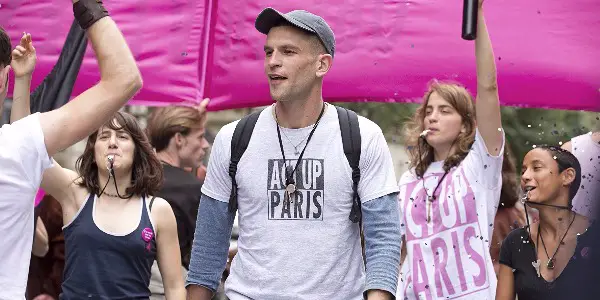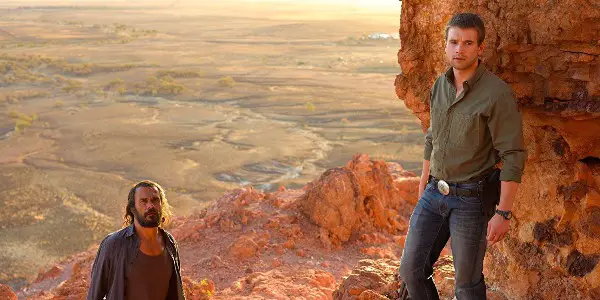Heartland Film Festival Report #2

Alex is a film addict, TV aficionado, and book lover.…
The Heartland Film Festival continues to offer every kind of movie under the sun, and in addition to the lovely ones I cover below, I had the pleasure of attending a Women in Film panel. Featuring women who have experience writing, directing, and producing features, the panelists offered advice on how to navigate the industry and support women in all areas. Additional topics in the wide-ranging discussion included how to cater to under-served and undervalued audience members (important tip: know the social media habits of your target audience), ageism against both the young and the old, and, of course, the recent attention given to sexual harassment. On the latter point, an optimistic note was reached, with the hope that men and women will come together to end the reprehensible behavior.
After that, it was off to more films covering everything from difficult history lessons to modern day social issues, with a good old-fashioned shootout to keep the adrenaline pumping.
BPM (Beats Per Minute) (Robin Campillo)

France’s submission for the Oscar Foreign Language category is reminiscent of previous films about AIDS activism and the gay rights movement, but it finds a beating heart and in doing so carves out a memorable place for itself within the canon.
BPM (Beats Per Minute) revolves around the Paris chapter of ACT UP (AIDS Coalition to Unleash Power) in the early 1990s. HIV/AIDS was at its most dire point then, having run rampant for 10 years with no effective treatments in sight. ACT UP served as an aggressive activism group that staged flashy, media-grabbing events that included storming office buildings and throwing loads of fake blood.
These methods were necessary because the afflicted were largely in ostracized communities, and governments and the medical companies were notoriously slow in addressing the epidemic. How bad was it? Discriminatory hangovers from the period still exist, with many countries banning men who sleep with men from donating blood to this day. To combat the indifference, ACT UP members laid their bodies out for everyone to see, but the group was plagued by fractious infighting as the dying bickered over how best to save their own and their loved ones’ lives.
BPM spends much time establishing the methods and players in this chaotic group, and the realism the film goes for immediately brings to mind the documentary How to Survive a Plague. It told the story of ACT UP in New York City, and as an explanation for how the group operated at the time, it far exceeds what BPM is able to dramatize.
Considering how long BPM spends in this mode, it begins to be concerning that it will be nothing more than a lesser version of that documentary. But a subtle shift occurs, and it becomes apparent that our audience surrogate, a new member named Nathan (Arnaud Valois), is taking us on a much more intimate journey.
It’s in this mode that the film really stands out, not only for taking an unflinching look at HIV/AIDS as it ravages a body, but how sexuality and loving relationships were affected within the LGBTQ community. Its bluntness will turn some people off (there were several walkouts in the screening I attended), so know that if you are bothered by graphic sex scenes or emotionally upsetting material, this probably isn’t the film for you.
But these elements are there for good reason in BPM and don’t have the exploitative feel of the headline-grabbing Blue is the Warmest Color. The intimacy comes across as just that, intimate, and the revelations that come from these scenes are what will make the film stick in your mind.
By its end, the film evens finds a way to pay off many of the earlier, seemingly lesser scenes in a sequence that crescendos with emotion. Not everything ends up having an established purpose, but the languid pacing and personal asides is a large part of what makes BPM a humane film about an inhumane time.
Goldstone (Ivan Sen)

Goldstone drew widespread renown last year when it released in Australia, but it’s yet to receive theatrical distribution in the U.S. and many other countries, making it a secure bet for a good time as it tours the festival circuit.
Don’t be deterred by the news that it’s a sequel to 2013’s Mystery Road; this movie stands on its own two feet, with bedraggled Indigenous detective Jay Swan (Aaron Pedersen) limping into a new town with plenty of dirt to uncover. Or, more accurately, he weaves into town in a drunken stupor, leaving local cop Josh (Alex Russell) to throw him in an open cell to sleep it off.
This opening does much to establish a familiar scenario: a nowhere town with laissez-faire law enforcement always has nefarious underpinnings, and the newly arrived stranger is certain to break the tenuous peace. It’s a Western transplanted to the Australian outback, complete with an ostracized native population and women in need of rescue.
Director Ivan Sen sets a deliberate pace, letting the mysteries sprawl out like the dusty town. The grit is relished in striking overhead shots, and the layout of this pop-up community lends an isolated, oppressive sense of dread that Sen milks for all its worth. If you weren’t already sold on the unconventional beauty of Australia’s interior, then Goldstone will sway you with its rugged vistas.
Of course, no good Western is complete without a parade of colorfully compromised individuals, and in Goldstone, Jacki Weaver leads the way. As the city’s mayor, her menace is felt as soon as she drops off her first pie, and you half expect her fruit to be poisoned like some evil Queen. Joining her is the awkward shorts wearing David Wenham, who heads the local mine that is the backbone of the town’s existence.
A proposed expansion to the mine has furthered trouble between the Indigenous people and the imported white man, and it’s no coincidence that detective Jay and cop Josh are representative of each group. The tension between them reflects the town’s moral struggle, and whether the inevitable shootout that ends the film has them on the same side or pitted against each other carries much larger implications.
In that way, Goldstone is a socially conscious piece, but it sticks to such familiar beats that overpraise feels undeserved. It’s a good genre piece that hits all the cozy markers of a Western, but it slides away as soon as you leave the theater.
Mixed Match (Jeff Chiba Stearns)

There’s something hopeful about educational documentaries, and I always find myself attracted to the enthusiasm that runs beneath their surfaces. That’s 100% the case for Mixed Match, which director Jeff Chiba Stearns has been touring with since 2016, racking up festival awards and toting cute plush stem cells in the hopes of getting more people on donor registries.
The film highlights the unfortunate reality facing mixed race blood cancer patients, who have curable illnesses if a matching bone marrow donor can be found. However, the donor lists often have a small percentage of mixed race people, meaning the likelihood of finding a match is substantially reduced.
The technical aspects of this, a.k.a. the science that gets me excited but bores most people, is swiftly moved through using some cleverly animated sequences, and none of it is harped on to an extensive degree. Enough is explained to give the audience a working knowledge, and really, the formula is pretty simple: more people on the donor list means a higher likelihood of finding matches, particularly for mixed race and minority groups.
Most of the film is taken up by firsthand accounts, which range from activists, scientists, and the ill. Now that may make the film seem like a downer, but Stearns makes sure to focus on the hopeful side, limiting truly gut-wrenching moments to sparsely placed and effective reminders of what’s at stake.
The mainstay through the documentary is Athena Asklipiadis, founder of Mixed Marrow and an advocate for mixed race patients. She’s often seen going out to visit the patients Stearns follows, but what becomes apparent is that the film isn’t a linear progression of events. Each encounter takes us through the stages of being on a transplant list, from the realization that death is a possibility, to the waiting, and (hopefully) the eventual procedure.
The demystifying of the process makes the thought of being a donor less scary, and considering Stearns brought a representative from Be A Match, a donor list organization, to the screening I attended and spent as much time fielding questions about donor registration as he did about his movie, his hopes for getting people engaged with the issue seemed to be completely met.
That doesn’t mean he ignores conflicting evidence, though, and there’s an admirable section of the film devoted to the debate over whether race should ever be taken into account during medical procedures. It’s an interesting aside, but ultimately Stearns has built such an effective film that it doesn’t really matter. He’s distilled everything into a basic, persuasive argument: there’s people who can be saved, and all that’s required is a relatively easy procedure for the donor. Why not sign up?
That covers my mid-week screenings at the Heartland Film Festival. Have you seen any of these films or are you interested in seeing any of them? Let us know in the comments!
Does content like this matter to you?
Become a Member and support film journalism. Unlock access to all of Film Inquiry`s great articles. Join a community of like-minded readers who are passionate about cinema - get access to our private members Network, give back to independent filmmakers, and more.
Alex is a film addict, TV aficionado, and book lover. He's perfecting his cat dad energy.













